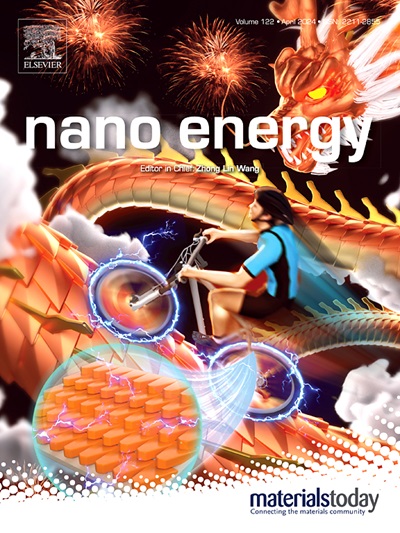构建吡咯并[3,2-b]吡咯烷酮连接的共价有机聚合物,促进 H2O2 的连续整体生产
IF 16.8
1区 材料科学
Q1 CHEMISTRY, PHYSICAL
引用次数: 0
摘要
无牺牲剂、太阳能驱动的光催化氧还原有望用于生产过氧化氢。然而,催化剂中电子-空穴对的快速重组以及氧气在催化剂表面缓慢的扩散速度极大地阻碍了过氧化氢的生产效率。为了解决这些问题,我们开发了一类新型的吡咯并[3,2-b]吡咯烷酮连接共价有机聚合物(COPs),并将其与微反应器技术相结合,以提高过氧化氢的合成效率。这些结构明确的聚合物以具有光活性的吡咯并[3,2-b]吡咯基为单位,由醛、苯胺和 2,3-丁二酮通过单锅三组分反应组装而成。将吡咯并[3,2-b]吡咯烷基整合到 COPs 中可形成供体-受体结构,从而促进光生电子和空穴的分离。其中,COP-2 的 H2O2 产率最高,达到 5446 μmol g-1 h-1。此外,我们还设计了一种盘管光微反应器,以提高气-液-固三相系统中的传质效率,从而将 H2O2 产率提高到 20285 μmol g-1 h-1,而无需使用牺牲剂。这项研究为将聚合物光催化剂与微流技术相结合提供了新的视角,凸显了未来绿色连续生产 H2O2 的潜力。本文章由计算机程序翻译,如有差异,请以英文原文为准。
![Construction of pyrrolo[3,2-b]pyrrolyl-linked covalent organic polymers to promote continuous overall H2O2 production](https://img.booksci.cn/booksciimg/2024-10/2024102210902855340923.png)
Construction of pyrrolo[3,2-b]pyrrolyl-linked covalent organic polymers to promote continuous overall H2O2 production
Sacrificial agent-free, solar-driven photocatalytic oxygen reduction holds promise for hydrogen peroxide production. However, the rapid recombination of electron–hole pairs in catalysts and the slow diffusion rate of oxygen on the catalyst surfaces significantly hinder the efficiency of hydrogen peroxide production. To address these issues, we developed a novel class of pyrrolo[3,2-b]pyrrolyl-linked covalent organic polymers (COPs) combined with microreactor technology to enhance hydrogen peroxide synthesis. These structurally well-defined polymers feature photoactive pyrrolo[3,2-b]pyrrolyl units were assembled from aldehyde, aniline, and 2,3-butanedione through a one-pot three-component reaction. Integrating pyrrolo[3,2-b]pyrrolyl moieties into the COPs creates donor–acceptor structures that facilitate the separation of photogenerated electrons and holes. Among them, COP-2 achieved the highest H2O2 yield of 5446 μmol g−1 h−1. Furthermore, we designed a coiled tube photomicroreactor to improve mass transfer efficiency in the gas–liquid–solid triphase system, boosting the H2O2 yield to 20285 μmol g−1h−1 without the need for a sacrificial agent. This study offers new insights into integrating polymer photocatalysts with microflow technology, underscoring the potential for future green and continuous H2O2 production.
求助全文
通过发布文献求助,成功后即可免费获取论文全文。
去求助
来源期刊

Nano Energy
CHEMISTRY, PHYSICAL-NANOSCIENCE & NANOTECHNOLOGY
CiteScore
30.30
自引率
7.40%
发文量
1207
审稿时长
23 days
期刊介绍:
Nano Energy is a multidisciplinary, rapid-publication forum of original peer-reviewed contributions on the science and engineering of nanomaterials and nanodevices used in all forms of energy harvesting, conversion, storage, utilization and policy. Through its mixture of articles, reviews, communications, research news, and information on key developments, Nano Energy provides a comprehensive coverage of this exciting and dynamic field which joins nanoscience and nanotechnology with energy science. The journal is relevant to all those who are interested in nanomaterials solutions to the energy problem.
Nano Energy publishes original experimental and theoretical research on all aspects of energy-related research which utilizes nanomaterials and nanotechnology. Manuscripts of four types are considered: review articles which inform readers of the latest research and advances in energy science; rapid communications which feature exciting research breakthroughs in the field; full-length articles which report comprehensive research developments; and news and opinions which comment on topical issues or express views on the developments in related fields.
 求助内容:
求助内容: 应助结果提醒方式:
应助结果提醒方式:


